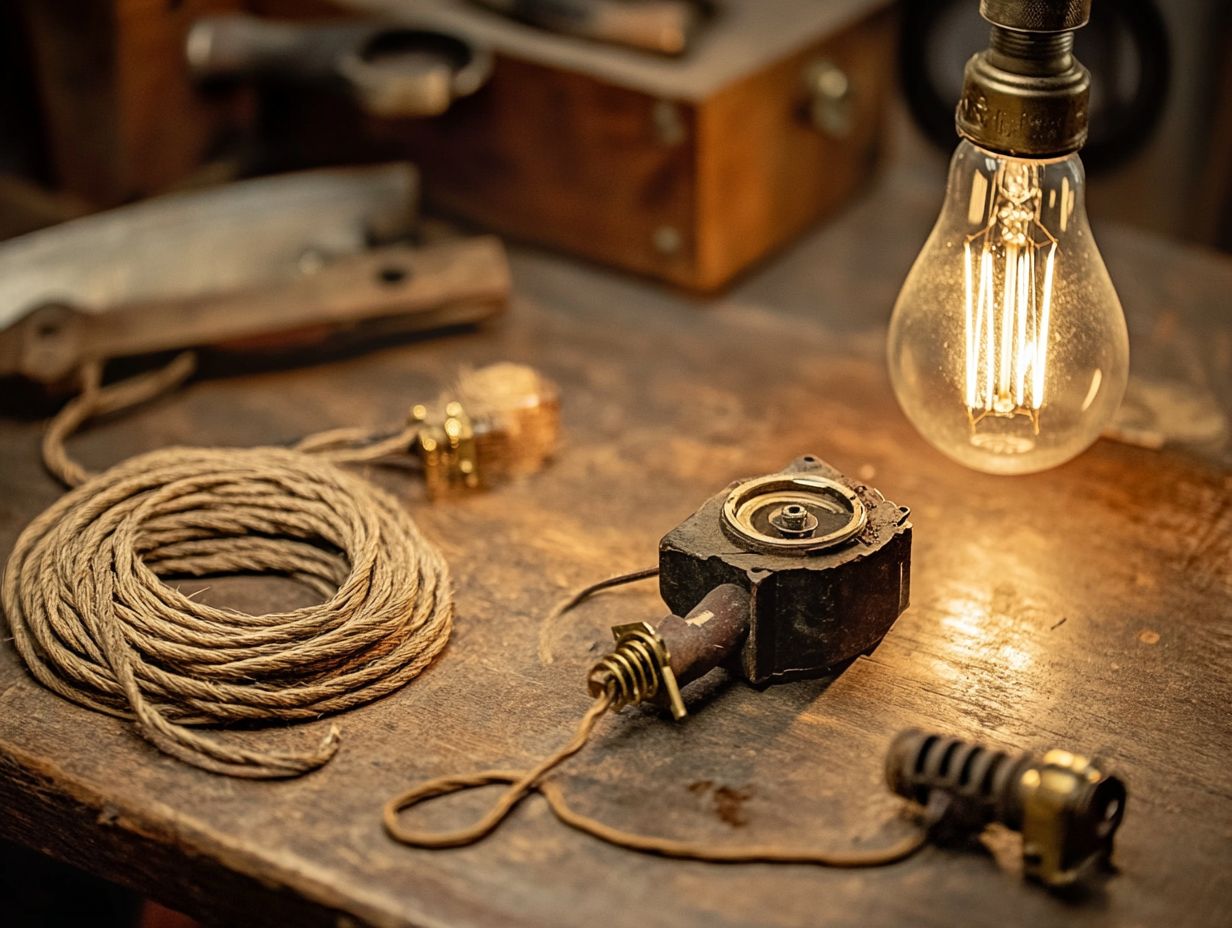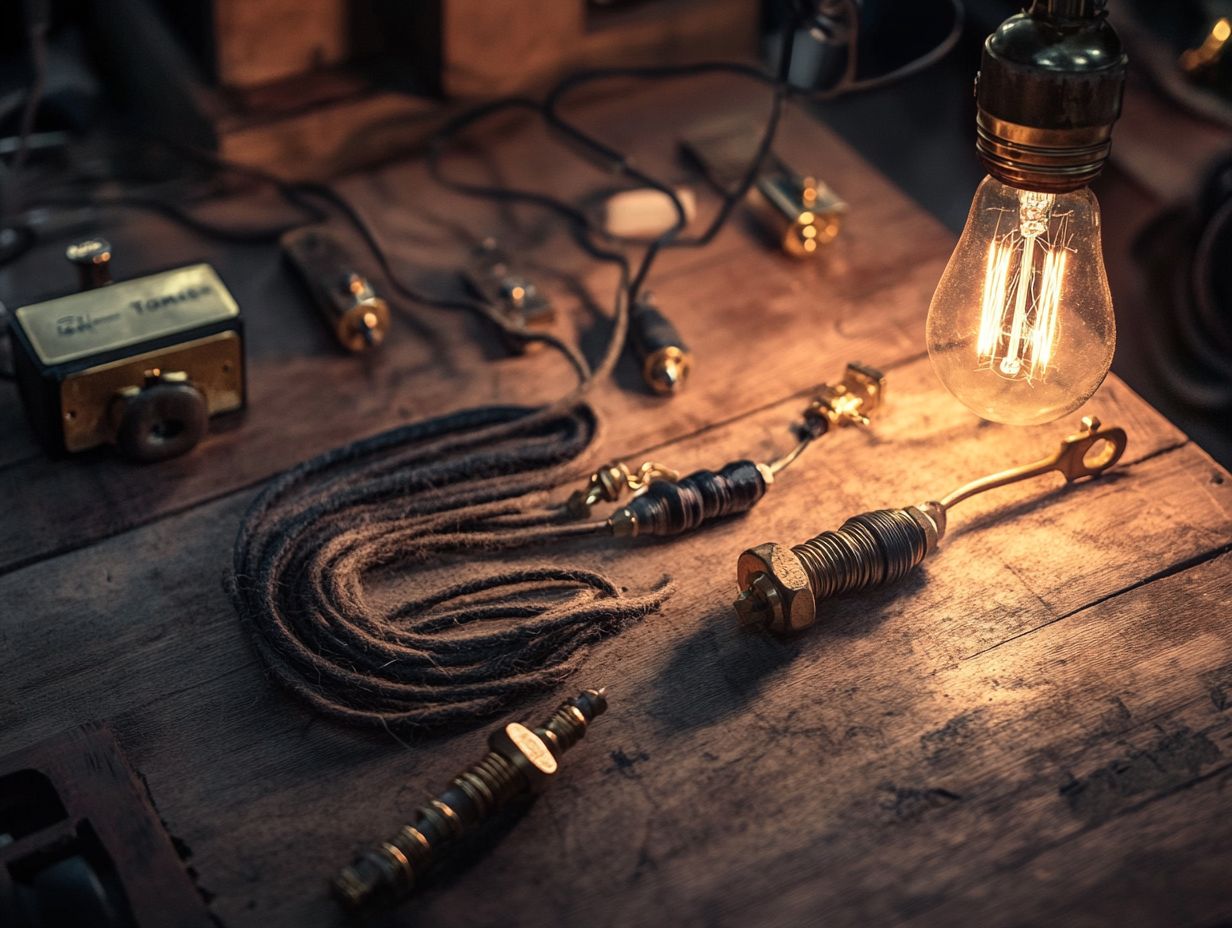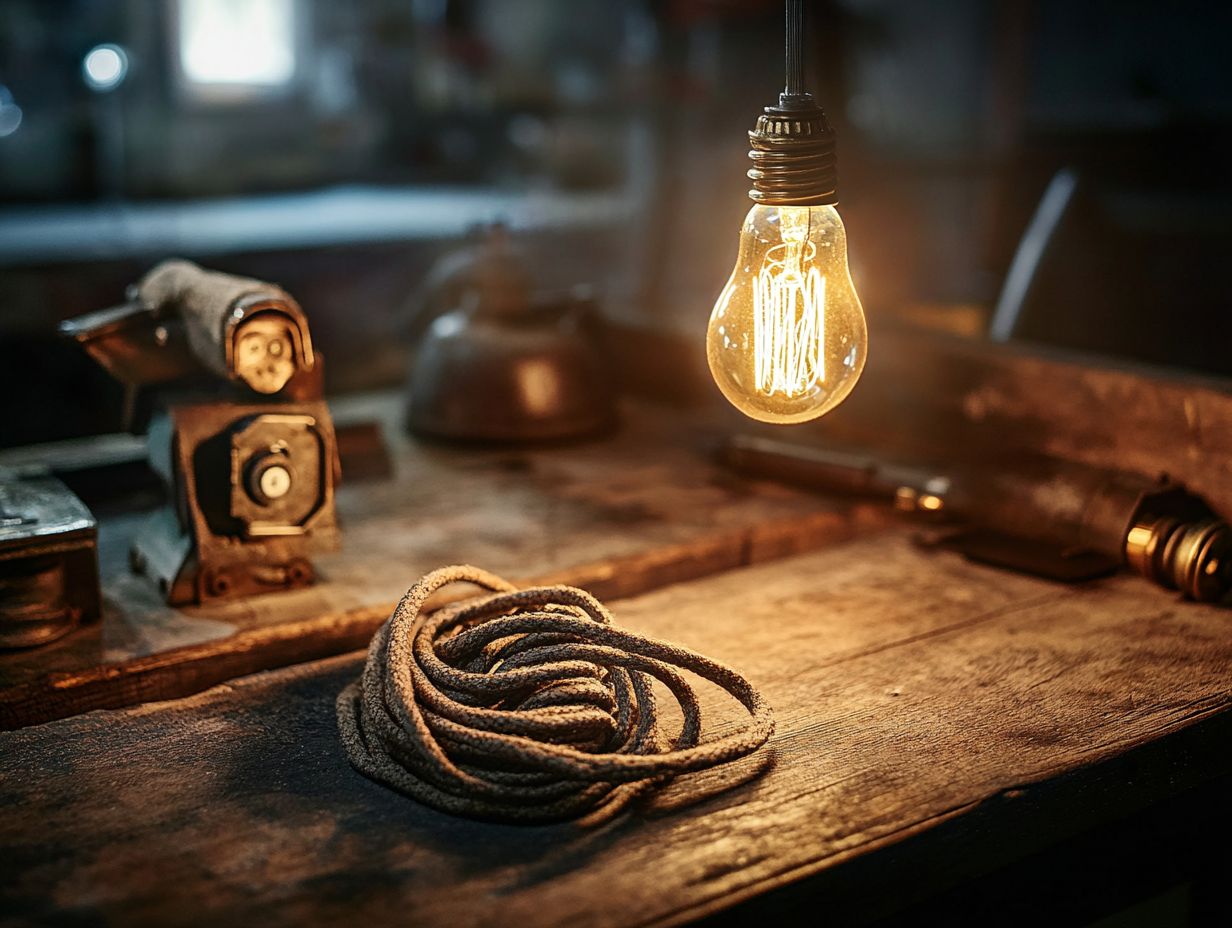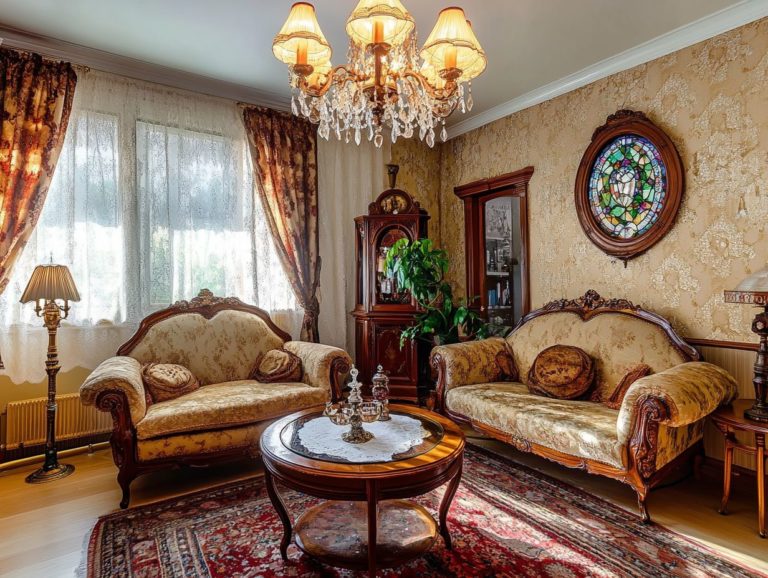Understanding Vintage Lighting Wiring
Let s dive into vintage wiring essentials! You ll learn what to look for and how to stay safe. Vintage lighting wiring offers a distinctive charm and character, yet it can also present significant risks if not fully understood.
This article covers common types of vintage wiring, such as cloth-covered and knob-and-tube wiring, while shining a light on their potential hazards. Discover how to identify vintage wiring in your home and recognize when it s time to consider upgrading for your safety.
Explore the allure and challenges of vintage lighting wiring, equipping yourself with the knowledge needed to make informed decisions.
Contents
Key Takeaways:

- Understanding vintage lighting wiring is crucial for the safety and functionality of your home’s electrical system.
- Common types of vintage wiring, such as cloth-covered and knob-and-tube, can pose potential hazards like fire and electrical shock risks.
- Identifying and upgrading vintage wiring is important for ensuring the safety and efficiency of your home’s electrical system.
What is Vintage Lighting Wiring?
Vintage lighting wiring includes distinct types of wiring found in antique lamps and light fixtures. These features diverge notably from contemporary electrical standards.
While these vintage systems can captivate your imagination, they also introduce challenges in terms of safety and meeting today s rules. For example, cloth-covered wiring, popular from the late 1800s to the mid-20th century, tends to deteriorate with time, increasing the risk of short circuits.
Similarly, knob-and-tube wiring is an old wiring method that uses knobs and tubes to support and protect the wires. This method lacks grounding and can present serious safety hazards.
Engaging installation specialists who understand the historical context of these wiring systems can offer invaluable insights during an electrical inspection. This helps you keep your home safe and stylish with the latest safety standards.
By taking this meticulous approach, you not only maintain the aesthetic allure of vintage fixtures but also uphold the safety and reliability demanded by modern electrical codes.
Common Types of Vintage Wiring
Common types of vintage wiring that you might encounter include cloth-covered wiring and knob-and-tube wiring, both prevalent in homes and businesses before the 1970s.
Cloth-covered wiring has an outer layer of fabric insulation that can deteriorate over time. Knob and tube wiring is characterized by individual conductors that run through porcelain knobs and tubes. This distinctive vintage method is still seen in many antique lamps and light fixtures today.
Cloth-Covered Wiring
Cloth-covered wiring, often found in antique lamps, features insulation made of fabric that can deteriorate over time. This creates potential fire hazards if not properly maintained or replaced.
While this wiring adds a vintage charm to older electrical devices, the pressing safety concerns it brings cannot be overlooked. Many homeowners admire its nostalgic aesthetic but often underestimate the wear and tear it endures over decades.
The fabric insulation is prone to fraying and deterioration, exposing the underlying wire and significantly increasing the risk of electric shock or fire. Failures in overcurrent protection pose a serious threat, as older wiring may lack modern safety features like circuit breakers.
This leaves circuits vulnerable to dangerous currents without appropriate safeguards. Therefore, while cloth wiring may evoke a sense of nostalgia, its potential hazards require your careful consideration and diligent maintenance.
Ready to ensure your vintage lighting is safe? Let s get started on your inspection today!
Knob and Tube Wiring

Knob and tube wiring represents a historical electrical system often associated with vintage lighting. It utilizes ceramic knobs to support wires and tubes to protect them as they navigate through walls and ceilings.
However, this antiquated system presents significant challenges in terms of modern safety measures and electrical inspection standards. Once celebrated for its simplicity and effectiveness in homes built from the late 1800s to the 1940s, knob and tube wiring connects wires directly, which can create potential overloading and safety hazards.
While it may offer certain advantages such as ease of installation and maintenance when managed correctly the risks it poses, particularly in light of today s rigorous electrical codes, cannot be ignored.
This outdated technology heightens the likelihood of electrical fires if not meticulously monitored and inspected. As a homeowner, grasping the implications of this wiring system is essential, as it underscores the importance of thorough inspections to ensure any existing knob and tube wiring remains safe and compliant with current standards.
Potential Hazards of Vintage Wiring
Vintage wiring, with its rich history and undeniable character, presents a range of potential hazards, including fire risks and electrical shock dangers. This is especially true if it hasn’t been updated to meet contemporary electrical codes and safety standards.
The implications of neglecting these safety measures can be severe, impacting both residential and commercial environments. Prioritizing these updates is essential to ensure a safe and secure space.
Fire Hazards
Fire hazards pose a significant concern when dealing with vintage wiring, especially given the deteriorating protective covering and outdated electrical circuits that likely don t meet modern safety standards.
Consider homes built in the early to mid-20th century, which often featured rubber-taped wiring. Over time, this protective covering can become brittle, increasing the risk of shorts and electrical fires.
According to the National Fire Protection Association (NFPA), about 30% of home fires stem from electrical malfunctions, and unfortunately, vintage wiring plays a role in this alarming statistic.
A case study from a local fire department revealed multiple incidents where malfunctioning circuits linked to older wiring systems were responsible for residential fires. Regular electrical inspections are vital to ensure your safety don’t overlook them!
Electrical Shock Risks
The risks associated with electrical shock in vintage lamps are significantly elevated due to outdated wiring methods and the lack of polarized plugs. This highlights the need for comprehensive safety measures when restoring or using these charming fixtures.
As these older models often utilize materials that have deteriorated over time, the chances of encountering exposed wires rise, increasing the potential for accidents. It s essential for anyone engaging with vintage electronics to acknowledge these hazards and take proactive steps.
For instance, using modern polarized plugs enhances safety by ensuring that connections are oriented correctly. Turning to qualified installation specialists can offer invaluable insights into the overall integrity of your electrical system.
How to Identify Vintage Wiring

Identifying vintage wiring requires you to meticulously examine a range of visual cues while employing testing methods to assess both the safety and compatibility of the wiring with modern electrical codes.
This process is essential for ensuring that antique lamps and light fixtures can be seamlessly integrated into contemporary environments, all while preserving electrical integrity and safety.
Don t wait until it s too late schedule your electrical inspection today!
Visual Clues and Testing Methods
Visual clues, such as frayed insulation or exposed circuits, can help you identify vintage wiring. Testing methods like voltage checks offer further assurance regarding the system’s safety and functionality.
You might also notice signs like outdated materials, such as cloth or rubber insulation that has become brittle over time. Ensuring safety demands more than just a watchful eye; professionals employ tools like multimeters to measure the amount of electric current and continuity. This provides you with a comprehensive understanding of the electrical system’s condition.
Infrared thermography can reveal hot spots that may indicate overloaded circuits, making it a critical assessment for maintaining safety standards. A thorough inspection by qualified electricians not only evaluates these factors but also ensures compliance with current codes, ultimately safeguarding your home and its occupants.
Upgrading Vintage Wiring
Upgrading vintage wiring is crucial for preserving both safety standards and the functionality of your antique lamps. This process may involve replacing cords, ensuring proper insulation, and adhering to modern electrical codes.
By enlisting the expertise of qualified installation specialists, you can ensure that these upgrades are executed accurately and safely. This allows you to enjoy your cherished pieces with peace of mind.
When to Upgrade and How to Do It
Knowing when to upgrade vintage wiring is essential for ensuring both safety and functionality. This is especially important during electrical inspections that may uncover potential fire hazards or electrical shock risks linked to outdated systems.
You might recognize the need for an upgrade if you frequently experience circuit breaker trips, flickering lights, or notice ungrounded outlets. It s important to stay vigilant for visible signs of damage, such as frayed wires or charred outlets, which suggest that your current system might not be able to handle modern electrical demands.
If your property is over 30 years old and still has its original wiring, it s prudent to consider an evaluation. To successfully upgrade, begin with a comprehensive assessment of your existing system.
Next, consult with a licensed electrician to select appropriate materials, ensuring that your upgrade meets current electrical codes for both safety and functionality.
Frequently Asked Questions

What is vintage lighting wiring?
Vintage lighting wiring refers to the electrical system used for lighting fixtures during the early 20th century. This type of wiring is characterized by cloth-covered wires and knob-and-tube connections. Many modern homes rely on safer alternatives, including compact fluorescent lamps.
What are the main components of vintage lighting wiring?
The main components of vintage lighting wiring include cloth-covered wires, porcelain or glass knobs and tubes, and a central brass or copper grounding wire.
Is it safe to use vintage lighting wiring?
Using vintage lighting wiring can be risky and is not advised! It does not meet modern safety standards and may pose a fire hazard due to its age and the materials used.
Can vintage lighting wiring be replaced?
Yes, vintage lighting wiring can be replaced with modern wiring. This is often necessary to ensure the safety and functionality of your lighting fixtures.
How can I identify vintage lighting wiring?
Vintage lighting wiring can be identified by its cloth-covered wires, knob-and-tube connections, and lack of grounding components. It is also typically found in homes built before the 1940s.
Don’t wait; get a professional evaluation today to ensure your safety! If you have any questions or experiences with vintage wiring, feel free to leave a comment below.
Are there any precautions to take when dealing with vintage lighting wiring?
Yes, it is very important to take precautions when handling vintage lighting wiring.
Wear safety gear, turn off the power supply, and get professional help if you’re unsure.






